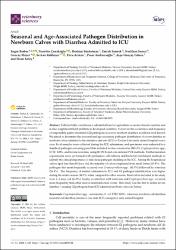Seasonal and Age-Associated Pathogen Distribution in Newborn Calves with Diarrhea Admitted to ICU
Citation
Berber, E.; Çanako˘ glu, N.; Sözdutmaz, ˙I.; Simsek, E.; Sursal, N.; Ekinci, G.; Kökkaya, S.; Arıkan, E.; Ambarcıo ˘ glu, P.; Göksu, A.G.; et al. Seasonal and Age-Associated Pathogen Distribution in Newborn Calves with Diarrhea Admitted to ICU. Vet. Sci. 2021, 8, 128. https:// doi.org/10.3390/vetsci8070128Abstract
Calf mortality constitutes a substantial loss for agriculture economy-based countries and is also a significant herd problem in developed countries. However, the occurrence and frequency of responsible gastro-intestinal (GI) pathogens in severe newborn diarrhea is still not well known. We aimed to determine the seasonal and age-associated pathogen distribution of severe diarrhea in newborn calves admitted to the intensive care unit (ICU) of Erciyes University animal hospital over a year. Fecal samples were collected during the ICU admissions, and specimens were subjected to a diarrheal pathogen screening panel that included bovine coronavirus (BCoV), Cryptosporidium spp., ETEC K99+, and bovine rotavirus, using RT-PCR and conventional PCR methods. Further isolation experiments were performed with permissive cell cultures and bacterial enrichment methods to identify the clinical importance of infectious pathogen shedding in the ICU. Among the hospitalized calves aged less than 45 days old, the majority of calves originated from small farms (85.9%). The pathogen that most frequently occurred was Cryptosporidium spp. (61.5%) followed by rotavirus (56.4%). The frequency of animal admission to ICU and GI pathogen identification was higher during the winter season (44.9%) when compared to other seasons. Most calves included in the study were 1-6 days old (44.9%). Lastly, co-infection with rotavirus and Cryptosporidium spp. occurred more frequently than other dual or multi-infection events. This study was the first to define severe diarrhea-causing GI pathogens from ICU admitted newborn calves in Turkey.


















